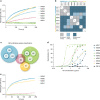A panel of human neutralizing mAbs targeting SARS-CoV-2 spike at multiple epitopes
- PMID: 32855401
- PMCID: PMC7452893
- DOI: 10.1038/s41467-020-18159-4
A panel of human neutralizing mAbs targeting SARS-CoV-2 spike at multiple epitopes
Abstract
The novel highly transmissible human coronavirus SARS-CoV-2 is the causative agent of the COVID-19 pandemic. Thus far, there is no approved therapeutic drug specifically targeting this emerging virus. Here we report the isolation and characterization of a panel of human neutralizing monoclonal antibodies targeting the SARS-CoV-2 receptor binding domain (RBD). These antibodies were selected from a phage display library constructed using peripheral circulatory lymphocytes collected from patients at the acute phase of the disease. These neutralizing antibodies are shown to recognize distinct epitopes on the viral spike RBD. A subset of the antibodies exert their inhibitory activity by abrogating binding of the RBD to the human ACE2 receptor. The human monoclonal antibodies described here represent a promising basis for the design of efficient combined post-exposure therapy for SARS-CoV-2 infection.
Conflict of interest statement
Patent application for the described antibodies was filed by the Israel Institute for Biological Research. None of the authors declared any additional competing interests.
Figures


Similar articles
-
A neutralizing human antibody binds to the N-terminal domain of the Spike protein of SARS-CoV-2.Science. 2020 Aug 7;369(6504):650-655. doi: 10.1126/science.abc6952. Epub 2020 Jun 22. Science. 2020. PMID: 32571838 Free PMC article.
-
Key residues of the receptor binding motif in the spike protein of SARS-CoV-2 that interact with ACE2 and neutralizing antibodies.Cell Mol Immunol. 2020 Jun;17(6):621-630. doi: 10.1038/s41423-020-0458-z. Epub 2020 May 15. Cell Mol Immunol. 2020. PMID: 32415260 Free PMC article.
-
Neutralizing nanobodies bind SARS-CoV-2 spike RBD and block interaction with ACE2.Nat Struct Mol Biol. 2020 Sep;27(9):846-854. doi: 10.1038/s41594-020-0469-6. Epub 2020 Jul 13. Nat Struct Mol Biol. 2020. PMID: 32661423
-
Targeting SARS-CoV2 Spike Protein Receptor Binding Domain by Therapeutic Antibodies.Biomed Pharmacother. 2020 Oct;130:110559. doi: 10.1016/j.biopha.2020.110559. Epub 2020 Aug 1. Biomed Pharmacother. 2020. PMID: 32768882 Free PMC article. Review.
-
Receptor-binding domain-specific human neutralizing monoclonal antibodies against SARS-CoV and SARS-CoV-2.Signal Transduct Target Ther. 2020 Sep 22;5(1):212. doi: 10.1038/s41392-020-00318-0. Signal Transduct Target Ther. 2020. PMID: 32963228 Free PMC article. Review.
Cited by
-
Induction of Superior Systemic and Mucosal Protective Immunity to SARS-CoV-2 by Nasal Administration of a VSV-ΔG-Spike Vaccine.Vaccines (Basel). 2024 May 1;12(5):491. doi: 10.3390/vaccines12050491. Vaccines (Basel). 2024. PMID: 38793742 Free PMC article.
-
Tapered chiral nanoparticles as broad-spectrum thermally stable antivirals for SARS-CoV-2 variants.Proc Natl Acad Sci U S A. 2024 Mar 26;121(13):e2310469121. doi: 10.1073/pnas.2310469121. Epub 2024 Mar 19. Proc Natl Acad Sci U S A. 2024. PMID: 38502692 Free PMC article.
-
Beta-spike-containing boosters induce robust and functional antibody responses to SARS-CoV-2 in macaques primed with distinct vaccines.Cell Rep. 2023 Nov 28;42(11):113292. doi: 10.1016/j.celrep.2023.113292. Epub 2023 Oct 28. Cell Rep. 2023. PMID: 38007686 Free PMC article.
-
Identification of T-Cell Epitopes Using a Combined In-Silico and Experimental Approach in a Mouse Model for SARS-CoV-2.Curr Issues Mol Biol. 2023 Sep 28;45(10):7944-7955. doi: 10.3390/cimb45100502. Curr Issues Mol Biol. 2023. PMID: 37886945 Free PMC article.
-
Circular RNA vaccine in disease prevention and treatment.Signal Transduct Target Ther. 2023 Sep 11;8(1):341. doi: 10.1038/s41392-023-01561-x. Signal Transduct Target Ther. 2023. PMID: 37691066 Free PMC article. Review.
References
MeSH terms
Substances
LinkOut - more resources
Full Text Sources
Other Literature Sources
Miscellaneous

